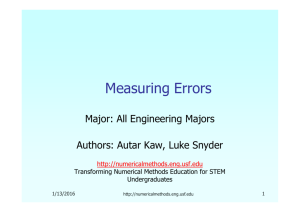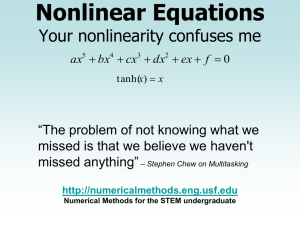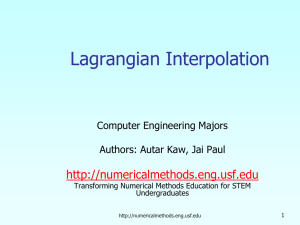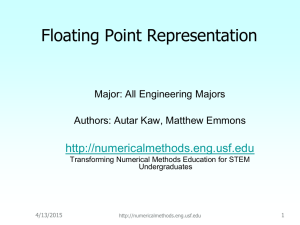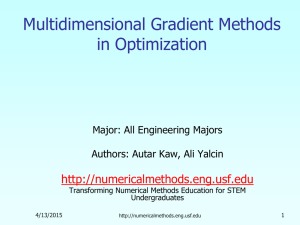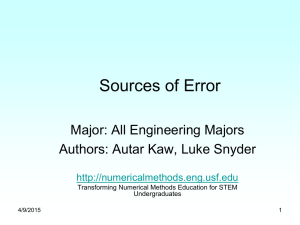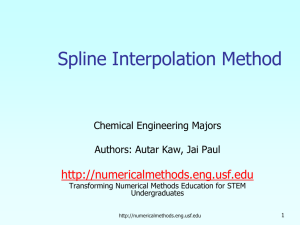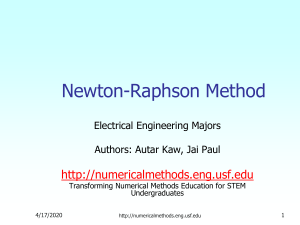PPT - Math For College
advertisement
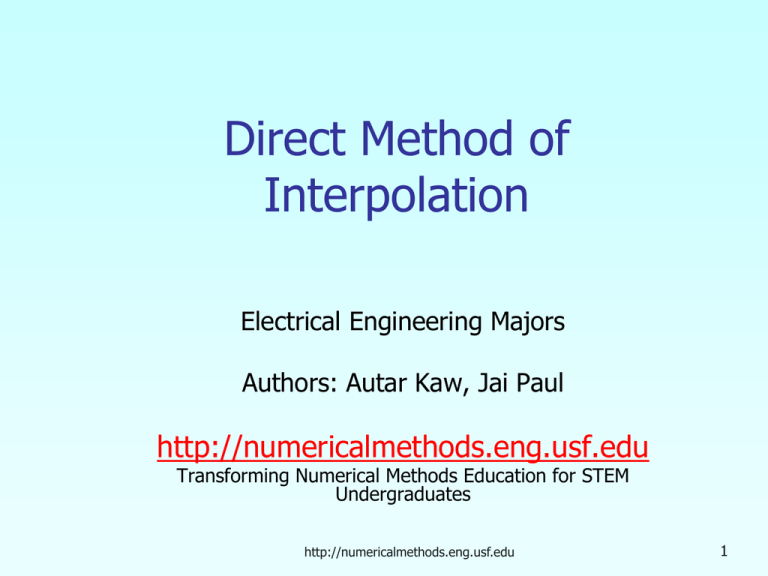
Direct Method of Interpolation Electrical Engineering Majors Authors: Autar Kaw, Jai Paul http://numericalmethods.eng.usf.edu Transforming Numerical Methods Education for STEM Undergraduates http://numericalmethods.eng.usf.edu 1 Direct Method of Interpolation http://numericalmethods.eng.usf.edu What is Interpolation ? Given (x0,y0), (x1,y1), …… (xn,yn), find the value of ‘y’ at a value of ‘x’ that is not given. Figure 1 Interpolation of discrete. 3 http://numericalmethods.eng.usf.edu Interpolants Polynomials are the most common choice of interpolants because they are easy to: Evaluate Differentiate, and Integrate 4 http://numericalmethods.eng.usf.edu Direct Method Given ‘n+1’ data points (x0,y0), (x1,y1),………….. (xn,yn), pass a polynomial of order ‘n’ through the data as given below: y a0 a1x .................... an x . n where a0, a1,………………. an are real constants. Set up ‘n+1’ equations to find ‘n+1’ constants. To find the value ‘y’ at a given value of ‘x’, simply substitute the value of ‘x’ in the above polynomial. 5 http://numericalmethods.eng.usf.edu Example Thermistors are based on materials’ change in resistance with temperature. A manufacturer of thermistors makes the following observations on a thermistor. Determine the temperature corresponding to 754.8 ohms using the direct method for linear, quadratic, and cubic interpolation. 6 R (Ω) T(°C) 1101.0 911.3 636.0 451.1 25.113 30.131 40.120 50.128 http://numericalmethods.eng.usf.edu Linear Interpolation T R a0 a1 R 40.12 T 911.3 a0 a1 911.3 30.131 T 636.0 a0 a1 636.0 40.120 42 40 38 ys f ( range) 36 f x desired 34 Solving the above two equations gives, 32 a0 63.197 a1 0.036284 30.131 30 946 x s 10 0 896 846 796 746 696 x s range x desired Hence T R 63.197 0.036284R, 636.0 R 911.3 T 754.8 63.197 0.036284754.8 35.809C 7 http://numericalmethods.eng.usf.edu 646 x s 10 1 Quadratic Interpolation T R a0 a1 R a2 R 2 T 911.3 a0 a1 911.3 a 2 911.3 30.131 2 T 636.0 a 0 a1 636.0 a 2 636.0 40.120 2 T 451.1 a0 a1 451.1 a 2 451.1 50.128 2 Solving the above three equations gives 5 a 0 . 096275 a 3 . 8771 10 a0 85.668 1 2 8 http://numericalmethods.eng.usf.edu Quadratic Interpolation (contd) T R 85.668 0.096275R 3.8771105 R 2 , 451.1 R 911.3 T 754.8 85.668 0.096275754.8 3.8771105 754.8 35.089C 2 50.128 The absolute relative approximate error obtained between the first and second order polynomial is 55 50 ys 45 f ( range) f x desired 35.089 35.809 a 100 35.089 2.0543% 40 35 30.131 30 400 500 451.1 9 600 700 800 900 x s range x desired http://numericalmethods.eng.usf.edu 1000 911.3 Cubic Interpolation T R a0 a1 R a2 R a3 R 2 3 T 1101.0 25.113 a 0 a1 1101.0 a 2 1101.0 a3 1101.0 2 3 T 911.3 30.131 a 0 a1 911.3 a 2 911.3 a 3 911.3 2 3 T 636.0 40.120 a0 a1 636.0 a 2 636.0 a 3 636.0 2 3 T 451.1 50.128 a 0 a1 451.1 a 2 451.1 a3 451.1 2 a1 0.13093 a0 92.759 5 a2 9.297510 10 3 8 a3 2.712410 http://numericalmethods.eng.usf.edu Cubic Interpolation (contd) T R 92.759 0.13093R 9.2975105 R 2 2.7124108 R 3 , 451.1 R 1101.0 T 754.8 92.759 0.13093754.8 9.2975105 754.8 2.7124108 754.8 35.242C 2 The absolute relative approximate error between the second and third order polynomial is 50.128 3 55 50 45 ys f ( range) 40 f x desired 35.242 35.089 a 100 35.242 0.43458% 35 30 25.113 25 400 451.1 500 600 700 800 900 x s range x desired 1000 1100 1200 1.10110 55 11 50 http://numericalmethods.eng.usf.edu 3 Comparison Table 12 Order of Polynomial 1 2 3 Temperature C 35.809 35.089 35.242 Absolute Relative Approximate Error ---------- 2.0543% 0.43458% http://numericalmethods.eng.usf.edu Actual Calibration 1 The actual calibration curve used is Substituting y T a0 a1 ln R a1 ln R a1 ln R 2 1 , and x ln R , gives the calibration curve as T 2 3 y a0 a1 x a2 x a3 x Find the calibration curve and find the temperature corresponding to 754.8 ohms. What is the difference between the results from cubic interpolation? In which method is the difference larger, if the actual measured value at 754.8 ohms is 35.285°C 13 R (Ω) T (°C) x (lnR) y (1/T) 1101.0 911.3 636.0 451.1 25.113 30.131 40.120 50.128 7.0040 6.8149 6.4552 6.1117 0.039820 0.033188 0.024925 0.019949 http://numericalmethods.eng.usf.edu 3 Actual Calibration y a0 a1 x a2 x 2 a3 x 3 y 7.0040 0.039820 a 0 a1 7.0040 a 2 7.0040 a3 7.0040 2 3 y 6.8149 0.033188 a0 a1 6.8149 a 2 6.8149 a3 6.8149 2 3 y 6.4552 0.024925 a0 a1 6.4552 a 2 6.4552 a3 6.4552 2 3 y 6.1117 0.019949 a 0 a1 6.1117 a 2 6.1117 a 3 6.1117 2 a0 2.5964 a1 1.2605 14 a2 0.20448 3 a3 0.011173 http://numericalmethods.eng.usf.edu Actual Calibration yx 2.5964 1.2605x 0.20448x 2 0.011173x3 , 6.1117 x 7.0040 1 However, since y , and x ln R , T 1 2 3 2.5964 1.2605ln R 0.20448ln R 0.011173ln R , 451.1 R 1101.0 T 1 T R , 451.1 R 1101.0 2 3 2.5964 1.2605ln R 0.20448ln R 0.011173ln R At R = 754.8, 1 T 754.8 2 3 2.5964 1.2605ln754.8 0.20448ln754.8 0.011173ln754.8 35.355C 15 http://numericalmethods.eng.usf.edu Actual Calibration Since the actual measured value at 754.8 ohms is 35.285°C, the absolute relative true error between the value used for Cubic Interpolation is 35.285 35.242 t 100 35.285 0.12253% and for actual calibration is 35.285 35.355 t 100 35.285 0.19825% Therefore, the direct method of cubic polynomial interpolation obtained more accurate results than the actual calibration curve. 16 http://numericalmethods.eng.usf.edu Additional Resources For all resources on this topic such as digital audiovisual lectures, primers, textbook chapters, multiple-choice tests, worksheets in MATLAB, MATHEMATICA, MathCad and MAPLE, blogs, related physical problems, please visit http://numericalmethods.eng.usf.edu/topics/direct_met hod.html THE END http://numericalmethods.eng.usf.edu


